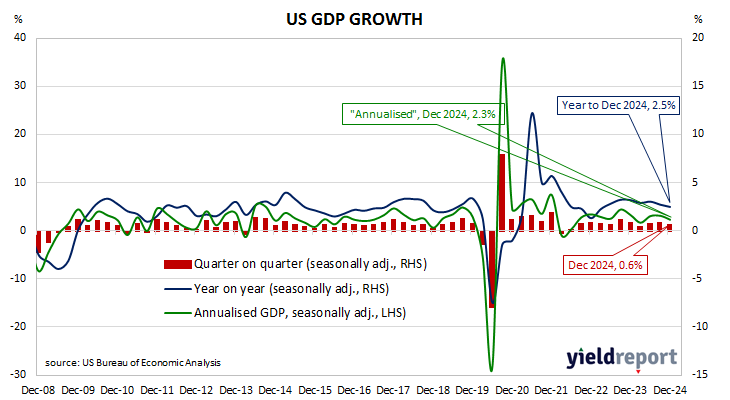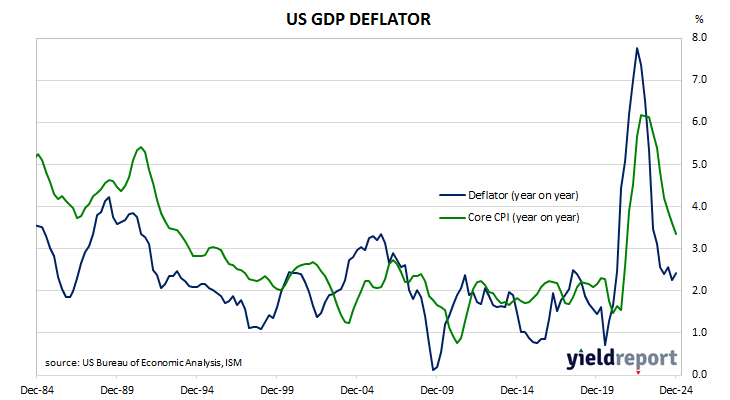Summary: US GDP up 0.6% (2.3% annualised) in December quarter, below expectations; up 2.5% over year; Westpac: downside surprise due to pullback in inventory accumulation; US Treasury yields decline; rate-cut expectations barely move; GDP price deflator rate accelerates from 2.3% to 2.4%.
US GDP growth slowed in the second quarter of 2019 before stabilising at about 0.5% per quarter. At the same time, US bond yields suggested future growth rates would be below trend. The US Fed agreed and it reduced its federal funds range three times in the second half of 2019. Pandemic restrictions in the June quarter of 2020 sent parts of the US economy into hibernation; the lifting of those same restrictions sparked a rapid recovery which lasted until 2022.
The US Bureau of Economic Analysis has now released the December quarter’s advance GDP estimate and it indicates the US economy expanded by 0.6% or at an annualised rate of 2.3%. The result was below the 2.6% (annualised) rise which had been generally expected as well as the September quarter’s 3.1% (annualised) increase. On a year-on-year basis, GDP expanded by 2.5%, down from 2.7% after revisions to the previous quarter.
“US GDP disappointed in Q4 2024, decelerating from 3.1% annualised in Q3 to 2.3%,” said Westpac senior economist Westpac Mantas Vanagas. “However, the downside surprise was solely due to a pullback in inventory accumulation, [with] domestic final demand growing 3.0% annualised, in line with the average of the prior three quarters and modestly higher than the long-term average prior to the pandemic.”
US GDP numbers are published in a manner which is different to most other countries; quarterly figures are compounded to give an annualised figure. In countries such as Australia and the UK, an annual figure is calculated by taking the latest number and comparing it with the figure from the same period in the previous year. The diagram above shows US GDP once it has been expressed in the normal manner, as well as the annualised figure.
US Treasury bond yields declined by modest amounts along the curve on the day. By the close of business, the 2-year Treasury bond yields had slipped 1bp to 4.21%, the 10-year yield had shed 3bps to 4.52% while the 30-year yield finished 2bps lower at 4.77%.
In terms of US Fed policy, expectations of a lower federal funds rate in the next 12 months barely moved. At the close of business, contracts implied the effective federal funds rate would average 4.31% in March, 4.225% in May and 4.16% in June. December contracts implied 3.88%, 45bps less than the current rate.
One part of the report which is often overlooked are the figures regarding the GDP price deflator, which is another measure of inflation. The GDP price deflator is restricted to new, domestically-produced goods and services and it is not based on a fixed basket as is the case for the consumer price index (CPI). These latest figures indicate the annual rate accelerated a touch from 2.3% in the September quarter to 2.4%.



